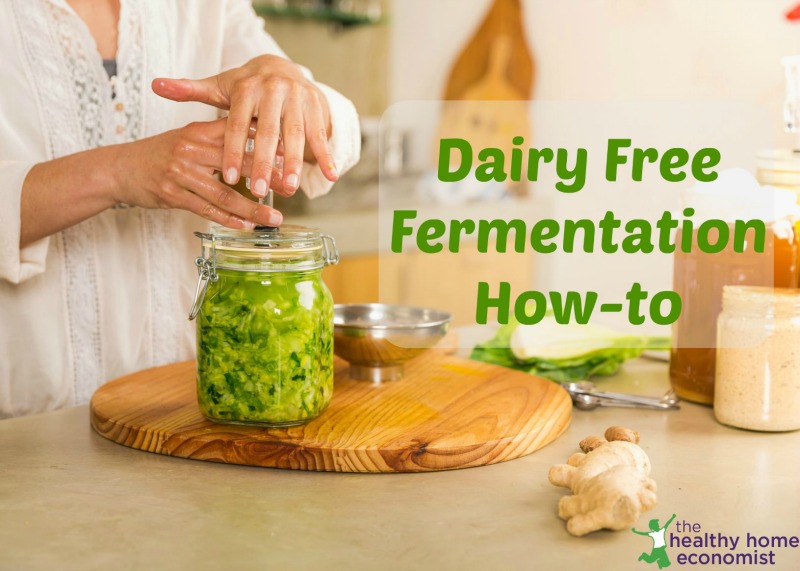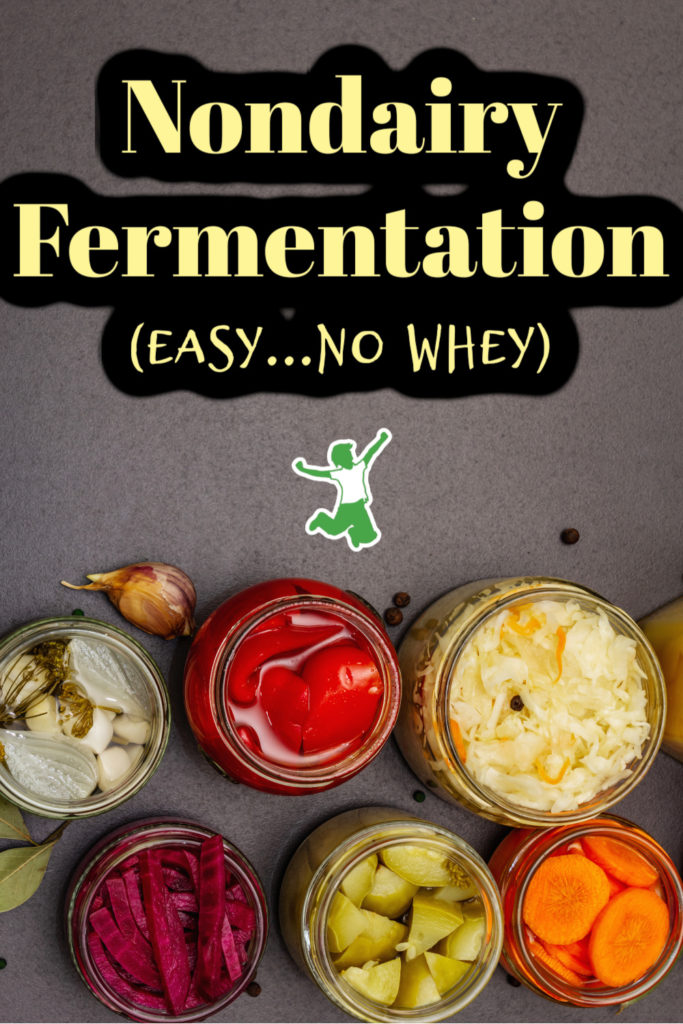Nondairy fermentation methods for culturing vegetables and fruits without whey or additional salt due to dietary restrictions.

In my eBook Real Food Fermentation Favorites (available via Healthy Home Plus), I discuss the history and enormous benefits of consuming fermented foods and beverages on a regular basis. Many recipes are also provided with guidance on which ones are best for particular h
I would suggest that consuming small amounts every single day would not be overdoing it. In fact, it would be in keeping with indigenous cultural practice.
More recently, the European Journal of Allergy and Clinical Immunology published that ferments are a potential mitigator of severe coronavirus disease and mortality due to the amazing immunity boost they provide!
Avoiding Whey as Fermentation Starter
You may have noticed that many traditional fermentation recipes recommend probiotic-rich liquid whey as the most common starter culture.
This provides the beneficial bacterial medium necessary to kick start the fermentation process.
Within a few days, this synergistic mix creates a plethora of additional enzymes and boosted vitamin content. Simple raw foods transform into super raw foods.
The problem is that milk is the source of liquid whey. What about folks who have a dairy allergy?
Is there another approach to fermenting foods and beverages that avoids whey as the microbial inoculant?
As a matter of fact, there are two ways to ferment without whey.
Fermentation fans can use either of these methods or a combination of the two with any whey-based recipes.
Salt Only Fermentation
Good quality sea salt is the easiest and most affordable way to ferment foods and beverages without a dairy-based inoculant.
Prior to modern refrigeration, indigenous cultures used salt to preserve food. Seasonally grown vegetables were not only preserved but also fermented this way.
Pros of Culturing with Salt
Using only salt to ferment foods has many advantages. First, the principle of osmosis tells us that a salty brine will naturally pull the water out of food. Since bacteria typically require moisture to thrive and grow, this naturally suppresses pathogenic bacteria and molds.
With pathogenic bacteria prevented from propagating, strains of beneficial Lactobacilli bacteria present on the surface of all living things can thrive and rapidly grow with no competition. Conveniently, these Lactobacilli are resistant to salt!
Cons of Salt Only Ferments
The downside to using salt is that the fermentation process is slower than when using whey. It is also not desirable for those who need to avoid salt for whatever reason.
In addition, salt-based fermentation is not optimal for use in beverages such as Hindu lemonade as the salt tends to overwhelm the sour/sweet flavor.
However, for cultured vegetables that will be stored for long periods of time, salt-only fermentation is a good choice.
How to Use
If you decide to ferment using salt only, the general rule of thumb is 2 tablespoons of good quality sea salt per quart of water. This creates the proper pH for the brine to optimally ferment the raw vegetables.
I enjoy using several different kinds of sea salt, but this brand is my favorite as it imparts the most flavor, in my opinion, with over 90 minerals and trace elements. It is also lower in sodium than other sea salts and tested to be free of contaminants.
In addition, I have confidence in this pristine sea salt again now that it is being tested.
Salt-free Fermentation
If you wish to minimize or eliminate the salt in your ferments, there are a few companies that offer vegetable starter cultures. I recommend either of these brands.
These single-use starter pouches contain beneficial microbes such as Lactobacillus plantarum and a prebiotic like inulin. This combination will ferment a wide variety of vegetables without any salt.
The downside of this salt-free fermentation approach, however, is that the veggies tend to get mushy and/or slimy. Another downside is that pathogenic microbes have the opportunity to run rampant without any salt to inhibit them. This increases the chances of fermentation mold.
Will a Probiotic Capsule Work?
Will a simple probiotic capsule work to kick off a ferment? Many people online claim that they successfully use this approach.
In some cases yes, a probiotic will work. However, this depends on the strains in the capsule.
For example, I would recommend a probiotic that contains Lactobacillus plantarum, Leuconostoc mesenteroidesas, and Pediococcus acidilactici which is what the vegetable starter pouches contain. I don’t know of a probiotic brand that contains all three of these. If you do, please post in the comments!
Ultimately, caution is the best policy with this approach. It may take a bit of trial and error to get this method to work. If you are up for that, then no reason not to try it!
Considering the expense of good quality organic vegetables these days and the limited time and patience we all have for failed ferments, it is best in my view to just use a tried and true vegetable starter culture where the potency is known.
How to Get the Best Results
For the best dairy-free fermentation results, use a small amount of pristine sea salt (1 tablespoon per quart of water) combined with a freeze-dried vegetable starter.
This approach will ferment as quickly as using liquid whey while preserving the crunchiness of the vegetables, enhancing flavor, and reducing the chance of mold.








Can I feed my cat raw whey? He is currently on antibiotic for sinus infection and I wonder if raw whey will cause inactive reaction in the antibiotic?
Holly Howe has a website with very complete instructions for making fermented vegetables. She weighs the amounts of all ingredients which I have found to be key in the success of fermenting. Not too salty, and no failed ferments (yet)! Good resource. 🙂
Iodine has many health benefits, and most of us in the US are severely deficient in this, in part because many former sources of iodine, such as slow-rising bread, and iodine tinctures for cuts, are not longer used. Also, the recommended daily allowance in the US is only enough to stay reasonably healthy, not to create the benefits of iodine, and people in parts of the world where iodine-rich foods are eaten regularly like seaweed, and iodine levels are much higher, people are generally healthier, and also have lower levels of cancer. Iodine has also been shown to reduce dense breast tissue which can sometimes be a precurser to cancer. I don’t know anything about it affecting fermentation, but I wanted to point out that it does have many health benefits, especially when ingested in higher levels than in the current standard American diet.
Thank you for this informative guide on how to ferment without whey! I’ve always wondered how to make it work because I’ve read so much on fermenting using salt. Thanks for sharing!
Marie, Windsor salt from Ontario contains iodine which interferes with fermentation and has no health benefits. Why would it be the best??
I’ve been making salt only ferments since the beginning- they just turn out better for me. I do use whey for fermented drinks and fruit though. I tried fermenting rhubarb this year with just salt and it didn’t turn out good, so next time I’ll use whey for that. I’m glad to hear that Real salt is safer- that’s what I have always used!
I wish you had included Airlocks. Cutting off the oxygen supply with a sealing vessel and water airlock that off-gasses, such as a crock with a moat, or a Probiotic Jar, or even a homemade all-glass bale-wire jar with a wine-maker’s bung, allows for vegetable fermenting with zero oxygen, and therefore zero mold growth.
No vegetable starters are necessary in an anaerobic environment, nor is whey or other acids needed to control mold growth. Vegetable starters don’t control mold effectively, and using higher levels of salt to control mold also inhibits healthy lactic acid bacteria development.
Enough cannot be said for the value of a one-time purchase or investment of time to prevent mold and guarantee success!
Airlocks work great, but it is just as easy to use fermentation weights in my experience. They are less expensive than buying new jars or lids too.
The best salt by far has been Windsor salt. It comes from the salt mine in Windsor, Ontario Canada
Didn’t know about that source! Thanks for sharing.
Thank you for the info, however Body Ecology’s starter states that it may contain trace amounts of dairy, so should not be labeled “dairy free” here.